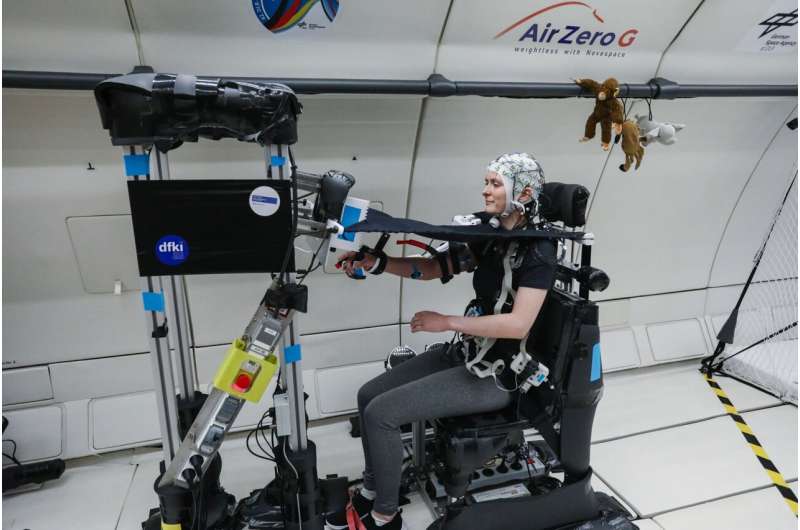In the NoGravEx project, they have developed an innovative approach to simulate microgravity with the help of a robotic exoskeleton. The technology is able to detect and compensate for the weight of a person's arms, making them feel weightless or as heavy as on the moon, for example.
The researchers are currently investigating the effects of simulated weightlessness on the human body compared to real weightlessness in the GraviMoKo project. By participating in the 42nd DLR Parabolic Flight Campaign from May 27 to June 6, 2024 in Bordeaux, France, they have reached an important milestone in the project.
During the parabolic flights, special ascent and descent maneuvers are used to create weightlessness 31 times for about 22 seconds each. This time is available to the scientific teams for their experiments. Instead of the planned three flights over three days, Novespace's Airbus A310 Zero G took off four times because the first flight had to be aborted after only 16 parabolas due to technical problems. The remaining parabolas were completed on the second day.
Experiment setup and execution
The exoskeleton experiment was one of eleven selected experiments on board the aircraft and involved the participation of six test subjects. However, in order to compensate for the absence of some subjects, more people had prepared for the mission in advance.
The test subjects' task was to use the index finger of their right arm to hit the center of a target slide on a touch screen in weightlessness. The arm was covered by a cape to avoid visual movement corrections. During the experiment, the subjects' arm muscle activity, brain activity, and heart rate variability, as well as their movement trajectories, were recorded.
Half of the test subjects had already practiced this task in the laboratory with an active exoskeleton in simulated weightlessness, while the others were untrained or only familiar with the test setup. In contrast to the terrestrial tests, passive systems were used for the parabolic flights. Two identical test setups allowed the simultaneous participation of two subjects per flight.
A backup person equipped with all the sensors was available to step in if the subjects felt uncomfortable, and otherwise act as an operator and supporter.
The experiments went largely according to plan, with only one subject having to be replaced due to nausea. At the end of the ten-day campaign, the researchers were very pleased with the results.
Project leader Prof. Dr. Elsa Kirchner, University of Duisburg-Essen/DFKI said, "We did a great job on our first parabolic flight campaign and collected all the data we planned to. Despite the effort and lack of sleep, the team worked extremely well together. Now it's time to analyze the very extensive data."
Data analysis and potential applications
By analyzing the data, the researchers hope to determine whether training with the exoskeleton in simulated weightlessness can enable the transfer of learned skills to real weightlessness and improve astronauts' abilities. This could help prepare astronauts for the challenges of future space missions and optimize their performance in the extreme conditions of space.
In addition to space travel, terrestrial applications such as rehabilitation can also benefit from this new technology. The exoskeleton used and further developed in the NoGravEx and GraviMoKo projects was originally developed at DFKI for rehabilitation therapy.
Thanks to the possibility of individual weight compensation, the system can provide even more personalized support for physically disabled people, for example, after a stroke.
Provided by Deutsches Forschungszentrum für Künstliche Intelligenz GmbH, DFKI



